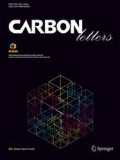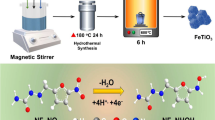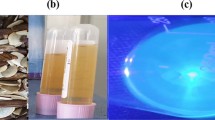Abstract
Highly luminescent carbon quantum dots (CQDs) are developed as fluorescent probes for selective detection of the heavy-ion Fe3+, where the CQDs exhibit excellent nontoxicity, functionalizability, sensitivity, and selectivity. Biomass-based CQDs and nitrogen-doped CQDs (N-CQDs) are synthesized for the selective detection of Fe3+ by using H2O2 as an oxidant and polyetherimide (PEI) as a nitrogen precursor by a green hydrothermal synthesis method. The prepared CQDs and N-CQDs exhibit an elliptical morphology and with an average particle size of 7 and 4 nm, respectively, and emit blue photoluminescence at 445 and 468 nm under excitation at 367 and 343 nm, respectively. The CQDs and N-CQDs exhibit good water solubility because of the abundant hydroxyl and carboxyl/carbonyl groups and graphic/pyrrolic/pyridinic nitrogen on the surfaces, giving rise to a quantum yield of about 24.2% and 30.7%, respectively. Notably, the Matrimony vine-PEI-based CQDs exhibit excellent Fe3+ selectivity and sensitivity relative to the Matrimony vine-based CQDs due to complexation of the numerous phenolic hydroxyl groups and nitrogen-containing groups with Fe3+, leading to increased fluorescence quenching, which greatly improves the sensitivity of detection. The minimum detection limit was 2.22 µmol L−1 with a complexation constant of 44.7.






Similar content being viewed by others
References
Ngole-Jeme VM, Ekosse GIE, Songca SP (2018) An analysis of human exposure to trace elements from deliberate soil ingestion and associated health risks. J Exposure Anal Environ Epidemiol 28:55–63
Zhou M, Zhou Z, Gong A, Zhang Y, Li Q (2015) Synthesis of highly photo luminescent carbon dots via citric acid and Tris for iron(III) ions sensors and bioimaging. Talanta 143:107–113
AL-Choubassi G, Kińska K, Bierla K, Lobinski R, Szpunar J (2020) Speciation of essential nutrient trace elements in coconut water. Food Chem. 339
Arumugham T, Alagumuthu M, Amimodu RG, Munusamy S, Iyer SK (2020) A sustainable synthesis of green carbon quantum dot (CQD) from Catharanthus roseus (white flowering plant) leaves and investigation of its dual fluorescence responsive behavior in multi-ion detection and biological applications. Sustain Mater Technol 23
Song Z, Chen X, Gong X, Gao X, Dai Q, Nguyen TT, Guo M (2020) Luminescent carbon quantum dots/nanofibrillated cellulose composite aerogel for monitoring adsorption of heavy metal ions in water. Opt Mater 100
Zhao SY, Song XP, Chai XY, Zhao PT, Liu ZW (2019) Green production of fluorescent carbon quantum dots based on pine wood and its application in the detection of Fe3+. J Cleaner Prod 263:121561
Bao T, Song L, Zhang S (2018) Synthesis of carbon quantum dot-doped NiCoP and enhanced electrocatalytic hydrogen evolution ability and mechanism. Chem Eng J 351:189–194
Wang MH, Yin HS, Zhou YL, Meng XJ, Waterhouse GIN, Ai S (2019) A novel photoelectrochemical biosensor for the sensitive detection of dual microRNAs using molybdenum carbide nanotubes as nanocarriers and energy transfer between CQDs and AuNPs. Chem Eng J 365:351–357
Liu XQ, Wang T, Zhou ZP, Yan YS (2019) A tailored molecular imprinting ratiometric fluorescent sensor based on red/blue carbon dots for ultrasensitive tetracycline detection. J Ind Eng Chem 72:100–106
Zhong D, Miao H, Yang K, Yang X (2016) Carbon dots originated from carnation for fluorescent and colorimetric pH sensing. Mater Lett 166(166):89–92
Chen Z, Sun L, Luo A, He Y, Zhang Y, Li Y (2015) Photoluminescent materials for highly toxic metals sensing: from downconversion to upconversion. Trends Environ Anal Chem 6–7:1–9
Li Y, Hu Y, Jia Y, Jiang X, Cheng Z (2019) N, S Co-Doped Carbon quantum dots for the selective and sensitive fluorescent determination of N-acetyl-l-cysteine in pharmaceutical products and urine. Anal Lett 52(11):1711–1731
Travlou NA, Giannakoudakis DA, Algarra M, Labella A, Rodriguezcastellon E, Bandosz TJ (2018) S- and N-doped carbon quantum dots: surface chemistry dependent antibacterial activity. Carbon 135:104–111
Liu Y, Liu Y, Park M, Park S, Zhang Y, Akanda R, Kim HY (2017) Green synthesis of fluorescent carbon dots from carrot juice for in vitro cellular imaging. Carbon Lett 21(1):61–67
Hallaj T, Amjadi M, Mirbirang F (2020) S, N-doped carbon quantum dots enhanced luminol-Mn(IV) chemiluminescence reaction for detection of uric acid in biological fluids. Microchem J 156:104841
Zhang S, Pei X, Xue Y, Xiong J, Wang J (2019) Bio-safety assessment of carbon quantum dots, N-doped and folic acid modified carbon quantum dots: a systemic comparison. Chin Chem Lett 31(6):1654–1659
Chen Y, Wu Y, Weng B, Wang B, Li CM (2016) Facile synthesis of nitrogen and sulfur co-doped carbon dots and application for Fe(III) ions detection and cell imaging. Sens Actuators B 223:689–696
Edison TN, Atchudan R, Shim J, Kalimuthu S, Ahn B, Lee YR (2016) Turn-off fluorescence sensor for the detection of ferric ion in water using green synthesized N-doped carbon dots and its bio-imaging. J Photochem Photobiol B 158:235–242
Niu W, Li Y, Zhu R, Shan D, Fan Y, Zhang X (2015) Ethylenediamine-assisted hydrothermal synthesis of nitrogen-doped carbon quantum dots as fluorescent probes for sensitive biosensing and bioimaging. Sens Actuators B 218:229–236
Hua J, Yang J, Zhu Y, Zhao C, Yang Y (2017) Highly fluorescent carbon quantum dots as nanoprobes for sensitive and selective determination of mercury (II) in surface waters. Spectrochim Acta A 187:149–155
Wei T, Wu L, Yu F, Lv Y, Chen L, Shi Y, Dai B (2019) Nitrogen self-doped porous carbon nanosheets derived from azo dye flocs for efficient supercapacitor electrodes. Carbon Lett 29(5):1–6
Aghamali A, Khosravi M, Hamishehkar H, Modirshahla N, Behnajady MA (2018) Synthesis and characterization of high efficient photoluminescent sunlight driven photocatalyst of N-Carbon Quantum Dots. J Lumin 201:265–274
Lan J, Liu C, Gao M, Huang C (2015) An efficient solid-state synthesis of fluorescent surface carboxylated carbon dots derived from C60 as a label-free probe for iron ions in living cells. Talanta 144:93–97
Choi J, Kim N, Oh J, Kim FS (2018) Bandgap engineering of nanosized carbon dots through electron-accepting functionalization. J Ind Eng Chem 65:104–111
Khataee A, Sajjadi S, Hasanzadeh A, Joo SW (2019) Synthesis of magnetically reusable Fe3O4 nanospheres-N, S co-doped graphene quantum dots enclosed CdSe its application as a photocatalyst. J Ind Eng Chem 75:230–237
Acknowledgements
This study was supported by grants from the National Natural Science Foundation of China (51703192), the 2020 Annual “Thirteenth Five Year” Planning Project of the Education Department of Jilin Province (JJKH20200515KJ), and the Innovation Team Project of Yanbian University (China).
Author information
Authors and Affiliations
Corresponding authors
Additional information
Publisher's Note
Springer Nature remains neutral with regard to jurisdictional claims in published maps and institutional affiliations.
Supplementary Information
Below is the link to the electronic supplementary material.
Rights and permissions
About this article
Cite this article
Liu, R., Zhang, Y., Piao, Y. et al. Development of nitrogen-doped carbon quantum dots as fluorescent probes for highly selective and sensitive detection of the heavy-ion Fe3+. Carbon Lett. 31, 821–829 (2021). https://doi.org/10.1007/s42823-020-00222-1
Received:
Revised:
Accepted:
Published:
Issue Date:
DOI: https://doi.org/10.1007/s42823-020-00222-1




